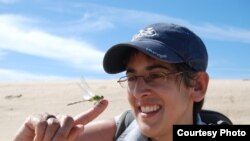Farmers reap surprising benefits from having areas that are biodiverse with many plant and animal species nearby, according to new research. A study finds that having diverse natural areas near agriculture helps farmers financially during droughts, and the more diverse the areas are, the better. Policies that preserve biodiversity near farms may ease economic pressure in places with severe droughts, the authors say.
"If you plant the same sort of crops next to a natural area that is very high in biodiversity versus one that's very low in biodiversity, [the positive effect] spills over into the agricultural products," said Frederik Noack, a professor of food and resource economics at the University of British Columbia who led the study.
Some of that spillover can be tied to the increased diversity of insects in places that host many different species of plants, experts say. Pollinators that help plants reproduce, like bees and moths, and spiders that prey on agricultural pests like aphids and beetles are especially important.
Noack hoped to learn if having biodiverse areas close to farms could help crops be more resistant to drought and if that impact would be big enough to be seen in farmers' incomes.
Big data from small farms
The researchers used data from 7,556 households in 304 villages in Asia, Africa and Latin America, where farmers derive their incomes from traditional agriculture as well as forest products like lumber and firewood.
Noack and his research team looked for a connection between the level of natural biodiversity in this case, the number of plant species in the area and how strongly drought affected the incomes of local farmers.
The researchers had expected that greater local biodiversity would benefit farmers, and it did. Farmers in areas with half the biodiversity lost twice as much income when droughts hit during the growing season.
Noack said that initially they thought the effect was just correlated with crop diversity. "Maybe you plant more different crops in areas with higher natural biodiversity because maybe there are just more crops available in those areas and that's actually what's driving the effect."
But that's not what they found. Even when they accounted for the effect of greater crop diversity, the farmers' incomes seemed to be stabilized just by being close to diverse natural areas that can host many types of pollinators.
Having access to forests was also an income stabilizer. Because forests are the result of many years of growth rather than just a single season, income from forest products is less susceptible to drought and can offset agricultural losses, the researchers found.
Encouraging conservation
Bruno Basso, an ecosystems scientist at Michigan State University who was not involved in the research, commented in an email that the researchers had been able to show that "biodiversity and forest conservation play a critical role in adapting and mitigating the negative effects of increased climate variability."
Noack hopes that this study can become part of the larger debate about conservation of natural areas.
"Should we just have protected area far away in areas that we don't use or shall we try to integrate that into normal land use?" said Noack. "This study actually says maybe we should at least have some level of biodiversity conservation in the agricultural landscape because of this positive spillover."
Basso agreed. "New global and local policy should specifically target conserving and enhancing biodiversity," he said.
This research is published in the Journal of the Association of Environmental and Resource Economists.




